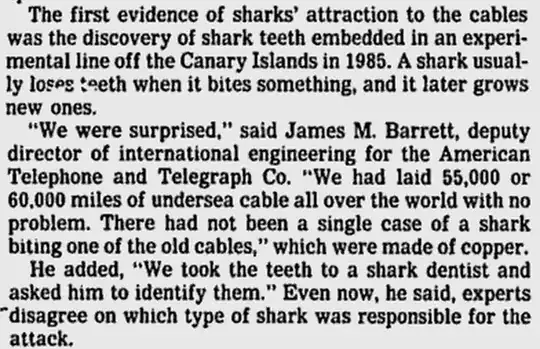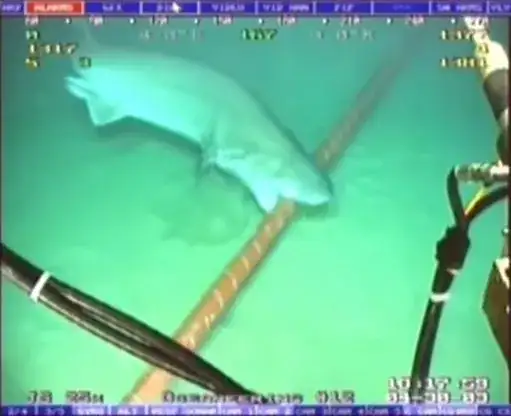Below are points of evidence supporting the fact that sharks are a threat to undersea cables.
EVIDENCE 1:
The first report of sharks attacking cables came from the Canary Islands in 1985, when sharks' teeth were found embedded in an experimental cable. I found the report in an old news paper.

According to a report by the United Nations Environment Programme and the International Cable Protection Committee Ltd.,
Fish, including sharks, have a long history of biting cables as identified from teeth embedded in cable sheathings. Barracuda, shallow- and deep-water sharks and others have been identified as causes of cable failure. Bites tend to penetrate the cable insulation, allowing the power conductor to ground with seawater. Attacks on telegraph cables took place mainly on the continental shelf and continued into the coaxial era until 1964. Thereafter, attacks occurred at greater depths, presumably in response to the burial of coaxial and fibre- optic cables on the shelf and slope. Coaxial and fibre-optic cables have attracted the attention of sharks and other fish. The best-documented case comes from the Canary Islands, where the first deep-ocean fibre-optic cable failed on four occasions as a result of shark attacks in water depths of 1,060–1,900 m [3,478 to 6,234 feet].
See also:
Marra, L.J., 1989. Shark bite on the SL submarine light wave cable
system: History, causes and resolution. IEEE Journal Oceanic
Engineering 14: 230–237
EVIDENCE 2:
A famous report by New York Times back in 1987 reported that the fibre optic cables linking the US, Europe and Japan were being nibbled persistently by sharks, causing phone and computer failures around the world.
The article also reported what was presented in Evidence 1, but adding as extra Dr. Nelson's claims:
In the report The finding that sharks are supersensitive to electrical
signals, able to detect electric fields as faint as a few millionths
of a volt per centimeter in water, is a recent significant discovery
in marine science, Dr. Nelson said.
The sharks may detect a faint field near the cable and attack. "Not
knowing any better, they try to eat it," Dr. Nelson said. "It's
programmed in their genes. Whether the field comes from a cable or
from a tin can, sharks are prone to behave as if they were
encountering a food item, and try to eat it up."
EVIDENCE 3:
It seems that the funniest battle now is not Google vs. Amazon or Google vs. Microsoft, but Google vs. Sharks.
Based on the comments made by Dan Belcher, a product manager on Google's cloud team, during the opening keynote of the company's Cloud Roadshow in Boston last week; Google invests heavily in protecting its trans-continental infrastructure, including wrapping cables in Kevlar to thwart attacks by hungry sharks.
BONUS:
A YouTube video showing a shark biting a submarine cable during a survey operation. It was spotted by a remotely operated underwater vehicle.
.
 :
:
UPDATE:
The cause isn't clear why Sharks bite cables.
Reasons for the attacks are uncertain, but sharks may be encouraged by
electro magnetic fields from a suspended cable strumming
in currents. However, when tested at sea and in the
laboratory, no clear link between attacks, electromagnetic
fields and strumming could be established. This lack of
correlation may reflect differences between the behaviour
of the deep-water sharks responsible for the bites and
that of the shallow-water species used in the experiments.
Whatever the cause, cables have been redesigned to improve their protection against fish biting.
UPDATE 2:
According to Submarine cables and the oceans: connecting the world report, external human aggression causes more faults for cables more than any other category,
with fishing accounting for nearly half of all reported faults. Anchoring is the second major cause of faults, with dredging, drilling, seabed abrasion and earthquakes also causing significant numbers. However, natural hazards including seabed abrasion, shark bites account for less than 10 per cent of all faults.
Shark bites account for only 0.5% for all faults. They're consider a threat, but it's a minor threat.

 :
: